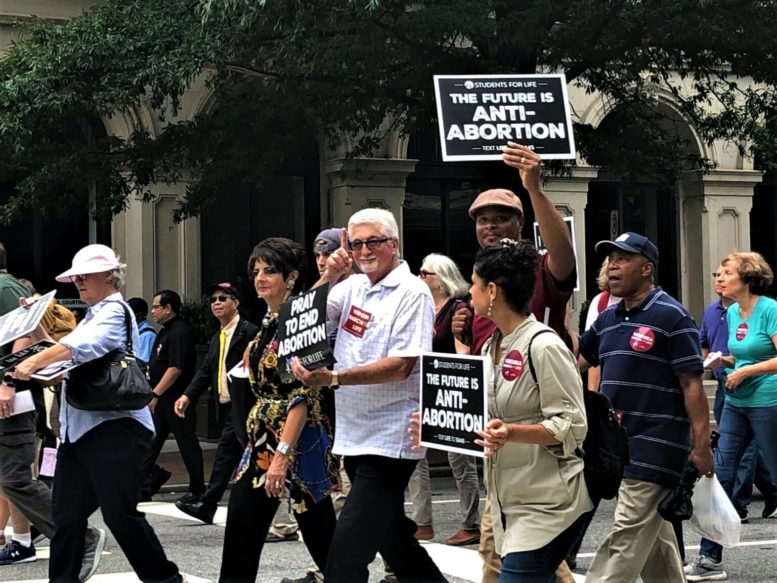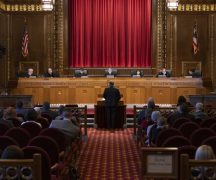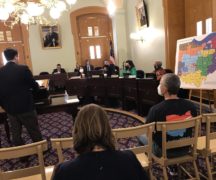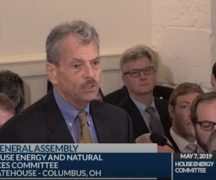BY SUSAN TEBBEN
Supporters of the newest abortion “trigger” ban in Ohio testified against “forcing” pregnant individuals to have the choice of abortion in the state, and faced tense exchanges with Democratic legislators.
The House Government Oversight Committee held its second hearing on House Bill 598 on Thursday, which would ban abortion in Ohio in the event that Roe v. Wade is overturned. The proposal does not include exceptions for rape or incest. It does create an “affirmative defense” for physicians, meaning doctors could defend themselves against criminal charges if they conduct an abortion under life-threatening situations.
Amendments to the bill were approved during the meeting, changing one element of the bill that would have left ectopic pregnancies as part of an abortion ban without an affirmative defense. Those types of pregnancies are life-threatening to the pregnant individual, because the fertilized egg implants itself outside of the uterus, making it a non-viable pregnancy. Physicians have said ectopic pregnancies can rupture and result in internal bleeding for the pregnant person if left untreated.
Committee vice-chair state Rep. D.J. Swearingen, R-Huron, introduced the amendment to include ectopic pregnancies in the list of situations in which an affirmative defense is allowed, though that does not equate to an “exception” under the bill.
Swearingen also entered an amendment into the bill, with no objections, that changed the wording of the bill to exchange “individual” for “woman” in any language about pregnant people in the bill.
Supporters, including Ohio Right to Life’s Paul Linton, said they were under the impression the legislature would wait to make any decision on abortion ban bills until after the U.S. Supreme Court releases its opinion on abortion bans in other states, directly linked to the fate of Roe v. Wade, which legalized abortion nationwide in the 1970s.
But that didn’t stop those hoping for a statewide abortion ban from pushing committee members to see their point of view. Allie Frazier, executive director of Right to Life of Northeast Ohio, said allowing the state to “force” pregnant people to have the choice of abortion does not create the bodily autonomy that abortion advocates might think.
“The question is ‘do we need to be able to kill our progeny to be free?’” Frazier said. “I don’t think that’s true.”
Frazier received push-back from Democratic representatives on the committee, who argued against the claims made by her and anti-abortion advocates that having abortion access oppresses those who become pregnant.
“I don’t see it as really being that liberation that you’re talking about as oppression. In fact, I see what is being placed upon women as a violence that we as legislators are going to do because it does not allow them to have that choice,” said state Rep. Paula Hicks-Hudson, D-Toledo.
Frazier acknowledged that men could have an easier time in terms of pregnancy, because they can “kind of walk away.” But just because “it’s not as easy for us to walk away” doesn’t give pregnant people or the legislators the right to approve of abortion.
“The government does have an interest in ensuring that none of our citizens and none of the human lives that exist within this state are being victimized, especially on a large scale,” Frazier said.
Dr. Michael Parker, OB/GYN and past president of the National Catholic Medical Association, argued that medical advances have progressed far enough that abortion should be considered “elective” and not vital to health care.
“This genetically distinct and inherently valuable human person is worthy of the same dignity and respect as all other human persons,” Parker told the committee. “Therefore, we see that abortion violates the basic tenets of medical ethics, to do no harm, because it ends the life of an unborn child.”
In making his case against abortion, he argued medicine has progressed even to in-utero surgeries for conditions like spina bifida. When pressed by legislators, Parker admitted that not only do those surgeries not typically happen until the second trimester, or 28 to 30 weeks gestation, doctors can’t typically diagnose the spinal condition until then because of the size of the fetus.
Current law in Ohio only allows abortion up to 22 weeks gestation.
Opponents will have their time in the committee room, possibly at the next meeting, which has yet to be scheduled. Pro-abortion groups and individuals have already spoken out about the bill and the potential downfall of Roe v. Wade.
Also from Ohio Capital Journal:
Bail reformers call on familiar evidence to advocate against reliance on cash bail
The day after Ohio House leaders put the brakes on cash bail-centric legislation, a different, long-simmering bail reform measure got it’s third hearing in committee. The measures offer alternative approaches to protecting public safety, and their supporters are invoking some of the same cases to make their point.
When the proponents of the cash bail measure introduced their plan in March of this year, they were flanked by Hamilton County prosecutor Joe Deters and Attorney General Dave Yost. Their pitch was a constitutional amendment directing judges to weigh any risk to public safety when they set the dollar amount of bail.
They needed that amendment, they said, because the state supreme court had ruled public safety is a valid consideration for some aspects of pre-trial release, just not the dollar amount.
Deters pointed to the case of Lonnell Anderson, who shot and killed Derek Smith while out on bond for a weapons charge. The judge set Anderson’s bail at $4,000 and he was able to secure his release by putting down one tenth of that amount. Deters argued it’s too easy for violent defendants to get out of jail and continue committing crimes.
“If you want to know the predictor of future behavior, it’s past behavior,” Deters argued. “These guys keep doing the same thing over and over again. This isn’t a secret and the judges have to have the ability to stop it.”
In committee Thursday, Alan Smith of the Buckeye Institute went in a different direction. He brought up the Anderson case in a list of murders that happened while defendants were out on bond, to make the point that they shouldn’t have had the opportunity to post bond in the first place.





